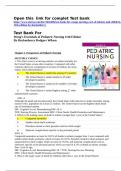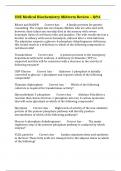Exam (elaborations)
Test Bank For Wong’s Essentials of Pediatric Nursing 11th Edition By Hockenberry Rodgers Wilson
- Course
- Testsbanks
- Institution
- Testsbanks
Test Bank For Wong’s Essentials of Pediatric Nursing 11th Edition By Hockenberry Rodgers Wilson
[Show more]




